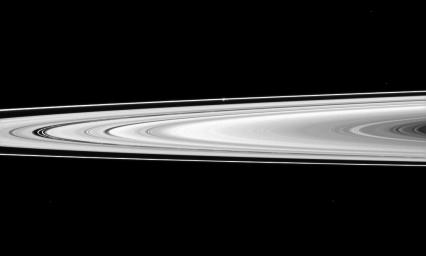
|
Across to Prometheus
- Click the image above for a larger view
- Full-Res JPEG (1018 x 612) (29.8 kB)
- Full-Res TIFF (1018 x 612) (623.9 kB)
Caption:
The Cassini spacecraft looks across Saturn's rings and finds the moon Prometheus, a shepherd of the thin F ring.
Prometheus (53 miles, or 86 kilometers across) looks like a small white bulge near the F ring -- the outermost ring seen here -- above the center of the image. See PIA08397 and PIA07712 to learn how the moon perturbs the F ring.
Kinky, discontinuous ringlets can also be seen in the Encke Gap of the A ring on the left of the image. See PIA12650 to learn more.
This view looks toward the southern, unilluminated side of the rings from about 1 degree below the ringplane. Four background stars are visible.
The image was taken in visible light with the Cassini spacecraft narrow-angle camera on Jan. 1, 2012. The view was acquired at a distance of approximately 1.1 million miles (1.8 million kilometers) from Prometheus. Image scale is 7 miles (11 kilometers) per pixel.
Background Info:
The Cassini-Huygens mission is a cooperative project of NASA, the European Space Agency and the Italian Space Agency. The Jet Propulsion Laboratory, a division of the California Institute of Technology in Pasadena, manages the mission for NASA's Science Mission Directorate, Washington, D.C. The Cassini orbiter and its two onboard cameras were designed, developed and assembled at JPL. The imaging operations center is based at the Space Science Institute in Boulder, Colo.
For more information about the Cassini-Huygens mission visit http://saturn.jpl.nasa.gov . The Cassini imaging team homepage is at http://ciclops.org .
Cataloging Keywords:
| Name | Value | Additional Values |
|---|---|---|
| Target | Prometheus | Encke Gap, F Ring, Saturn Rings |
| System | Saturn | |
| Target Type | Satellite | Gap, Ring |
| Mission | Cassini-Huygens | |
| Instrument Host | Cassini Orbiter | |
| Host Type | Orbiter | |
| Instrument | Imaging Science Subsystem (ISS) | |
| Detector | Narrow Angle Camera | |
| Extra Keywords | Grayscale, Visual | |
| Acquisition Date | ||
| Release Date | 2012-03-05 | |
| Date in Caption | 2012-01-01 | |
| Image Credit | NASA/JPL-Caltech/Space Science Institute | |
| Source | photojournal.jpl.nasa.gov/catalog/PIA14598 | |
| Identifier | PIA14598 | |
